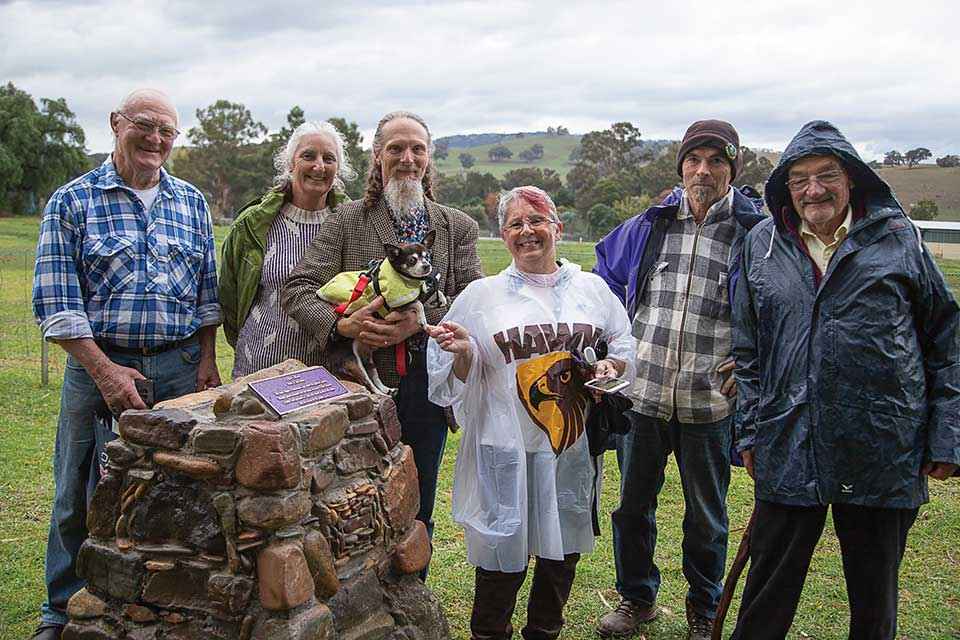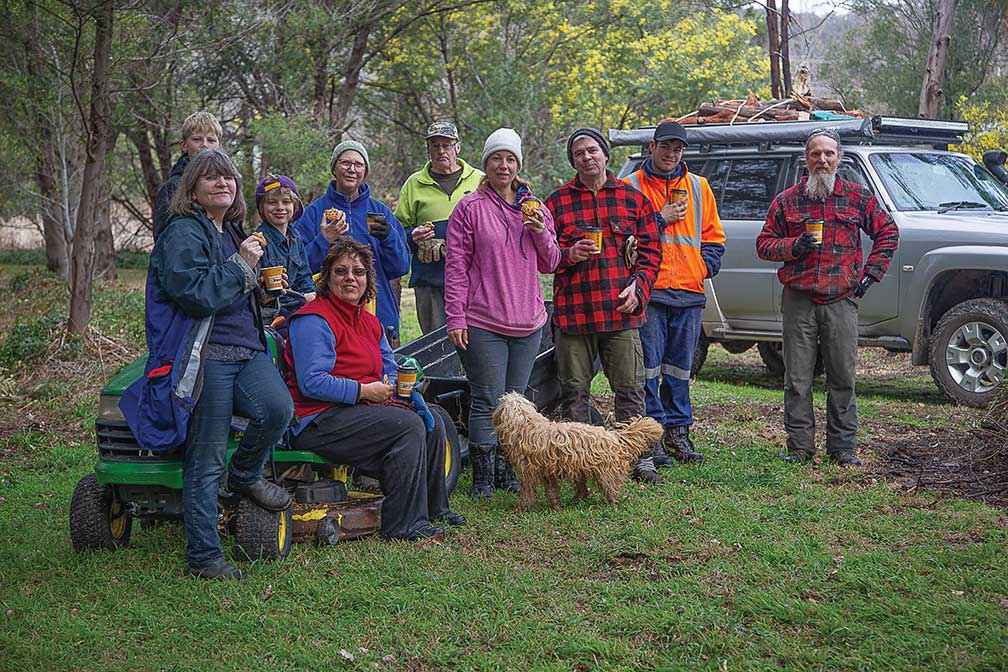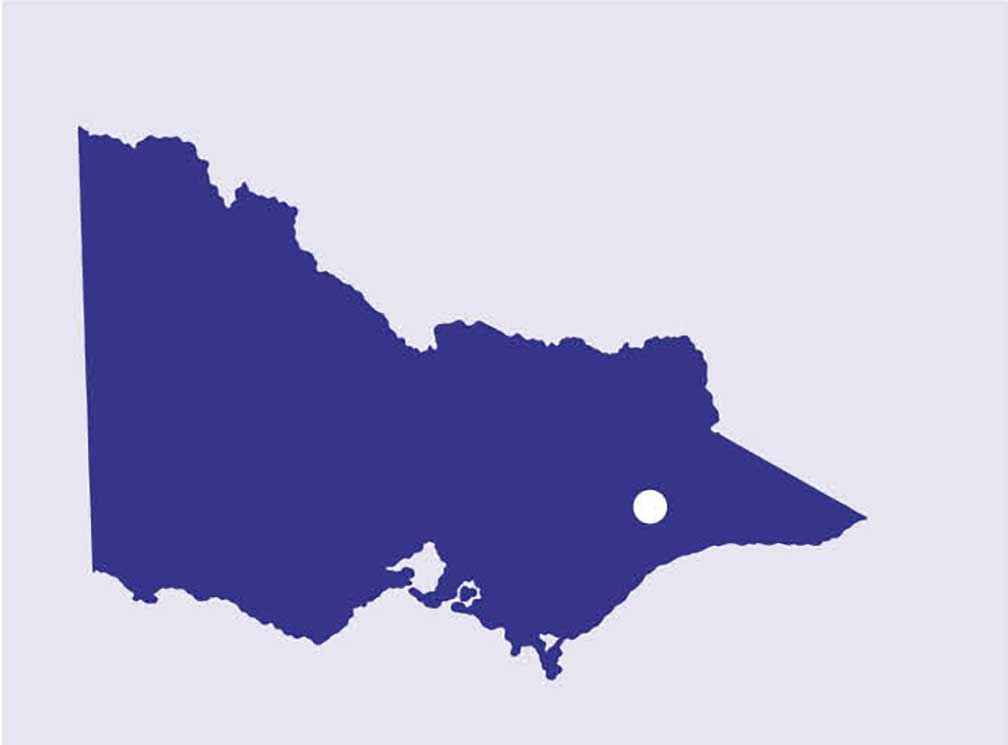Victorian Landcare Magazine - Spring 2020, Issue 79

In 2002 sculptor and poet John Butler adopted a neglected parcel of Crown land that wrapped around part of the township of Swifts Creek where he lived, at the site where the creek named for the township and the Tambo River merge. John was inspired by the creek and its majestic old manna gums and grey boxes that provide important habitat for local wildlife. His vision was to rehabilitate the land for local use by building a walking track marked by stone cairns with verses from his poem, The River.
John worked with local students to clear the 1.2-kilometre track. DELWP and the neighbouring landowner then started to mow the track. Cattle and sheep kept the weeds down, but blackberries took over once the stock were fenced out.
John passed away in 2014 before his dream was realised. Fortunately, he left some clues behind – the poem, sketches of handmade cairns and some preliminary concrete slabs along the track, now overgrown with grass and weeds.
In 2017 the East Gippsland CMA provided Swifts Creek Ensay Landcare Group (SCELG) with Regional Riparian Action Plan funding to undertake weed control work along the riverbank. Locals attended a community meeting where stories about John Butler and the proposed walk were shared. The Poet’s Walk Working Group, under the auspice of the SCELG, was formed and planning got underway. The East Gippsland Shire Council (EGSC) and DELWP helped us unravel the intricacies of land ownership and responsibilities.
Spraying blackberries came first. A local spraying contractor worked his way from the edges of the mountainous berries into the centre. We engaged Gunaikurnai Land and Waters Aboriginal Corporation and the local Gippsland Drought Employment Program crew who mulched up the weeds, felled hazardous trees and burnt old peppercorns. Regular working bees were held, with locals turning up with shovels, trailers, wheelbarrows, and tractors for the heavy work.
Hot cuppas and cake around the burning piles were a welcome reward and helped to build a strong bond within the group. Soon, we could see the Swifts Creek and Tambo River safely without being harmed by thorns and barbed wire.

Above: Volunteers from The Poet’s Walk Working Group enjoy a hot drink after a working bee.
Our first trial planting section was sprayed, weed mat was laid and the plants put in. Wood chip mulch was not able to be used due to the bushfires in the area and some weeds grew beneath that lifted the weed mat.
We used a different method for two new sections. The areas were dug over completely, weed mat laid and mulch put on thickly straight away.
The group has learnt many lessons along the way. We know that good site preparation is critical, although plant selection can be trial and error. Follow up watering is essential as is mulching and weeding regularly. Some plants were not planted deep enough so training for volunteers was needed.
East Gippsland Shire Council provided a heritage grant to complete six hand crafted cairns along the track, and one bankside flood marker, marking the height of the 1998 flooding of the creek. A local stonemason was employed and held a workshop to share his knowledge and skills. John’s poem was engraved on to metal signs, and attached, verse by verse, on to the cairns.
SCELG members were inspired to learn more about the ecology of the waterways. With the support of the Swifts Creek Angling Club and the Great Alpine Gallery we invited freshwater ecologist John Gooderham from National Waterbug Blitz to run an on-site workshop. Then the gallery held a series of workshops for locals to create replicas of the tiny water creatures that live within it. This project, called The Living River, was funded by the Foundation for Rural and Regional Renewal and EGSC.
The Poet’s Walk was launched in May 2019 with a twilight parade of the handmade waterbugs – nearly 100 sculptures from tiny to huge.

Above: One of the 100 waterbug sculptures that lit the way on the evening launch of The Poet’s Walk in 2019.
Locals walked the trail and viewed the stone cairns. John Butler’s wife Judith was part of the celebration and his son David performed a reading of his father’s poem. The township had been in drought, but the evening was also marked by a downpour – another gift to the environment.
The SCELG was highly commended in the Landcare Community Group Award category at the 2019 Victorian Landcare Awards for the project, and the Working Group won the Community Group of the Year in the Omeo Lions Club’s Australia Day Awards in 2020.
In 2019 the EGSC added The Poet’s Walk to its asset register and has taken responsibility for its maintenance, improvements and care. It has been a wide-reaching collaboration between The Poet’s Walk Working Group and many other community groups and government agencies.
As part of a grant from East Gippsland Water we produced a Poets Walk Plant Guide to encourage others to plant along the waterways. The guide gives advice on planning, planting times, precautions, site location, species selection, site preparation, ongoing maintenance and plant propagation. It is available on the Great Alpine Gallery website, and The Poet’s Walk Facebook page. Go to https://www.greatalpinegallery.org.au/_media/poetswalk/poets_walk_plant_guide_final_260620.pdf
The Poet’s Walk project continues with much energy and enthusiasm. All plantings are monitored regularly, and the plant guide updated as needed.
Following the success of the art workshops, we are now planting an eco-dye and basketry resources garden, with plants that are endemic to the area.
The project has brought the community together to protect and enhance our local environment for now and for future generations. It is a testament to John Butler’s vision.
Lisa Lee is the Landcare Facilitator for the Benambra, Dinner Plain, Omeo and Swifts Creek Ensay Landcare Groups. Her position is funded through the Victorian Landcare Facilitator Program.
For more information on the Poet’s Walk email Anne Richardson from The Poet’s Walk Working Group at anne@riverleablue.com The studies, and our constant communications with MRSC staff about poor practices, have yielded results. We have received grants, been alerted about forthcoming work and have an agreement to manage a particularly precious roadside.

Above: Location map - Swifts Creek